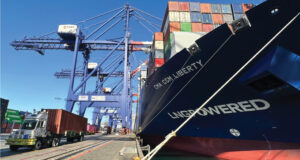America’s more than 300 ports are a vital part of a strong and healthy economy connecting manufacturers, businesses and farmers to the global marketplace and creating vital jobs for hardworking Americans.
By Elaine L. Chao, U.S. Department of Transportation Secretary
America’s more than 300 ports are a vital part of a strong and healthy economy connecting manufacturers, businesses and farmers to the global marketplace and creating vital jobs for hardworking Americans. Since 2007 alone, ports have created 9.8 million new jobs for a total of 23 million port-related jobs in the United States.
Ports also help strengthen our country’s competitiveness by moving exports and imports quickly and efficiently to domestic and global markets. Without modern, intermodal ports, the U.S. will not be able to maintain its position as a global leader in trade. Ports form hubs of intermodal systems by connecting waterways, roads, rail and even air transport, which work together to efficiently and safely move people and freight. The Department of Transportation and the Maritime Administration (MARAD) are helping ports improve their intermodal capacity to contribute to economic growth and job creation.
As the economy continues its recent growth, freight movement is rising, which increases the demand for ports of all sizes and uses. Our ports must be able to accommodate economic growth, as well as reduce congestion. This means they need to be brought up-to-date and modernized through smart investments. For the system to work efficiently, ports must be connected intermodally to rail, highways and other necessary infrastructure. That enhances their ability to do the essential job of moving freight safely and seamlessly from the heartland to international markets. American industry and jobs depend on this.
But today, our ports face challenges. Chief among these are aging and crumbling infrastructure. One example is the port of Eastport in Maine. The port’s breakwater collapsed in December 2013 due to years of severe deterioration, causing the local economy to suffer. While closed, it displaced more than 40 fishing vessels, lost revenue for berthing and vessel supply, and was closed to the public and the Coast Guard. To repair it as quickly as possible, a $6 million grant was awarded by the Department of Transportation and was combined with state and local funds to get the project underway. It was officially reopened in July 2017.
 AAPA Seaports
AAPA Seaports


